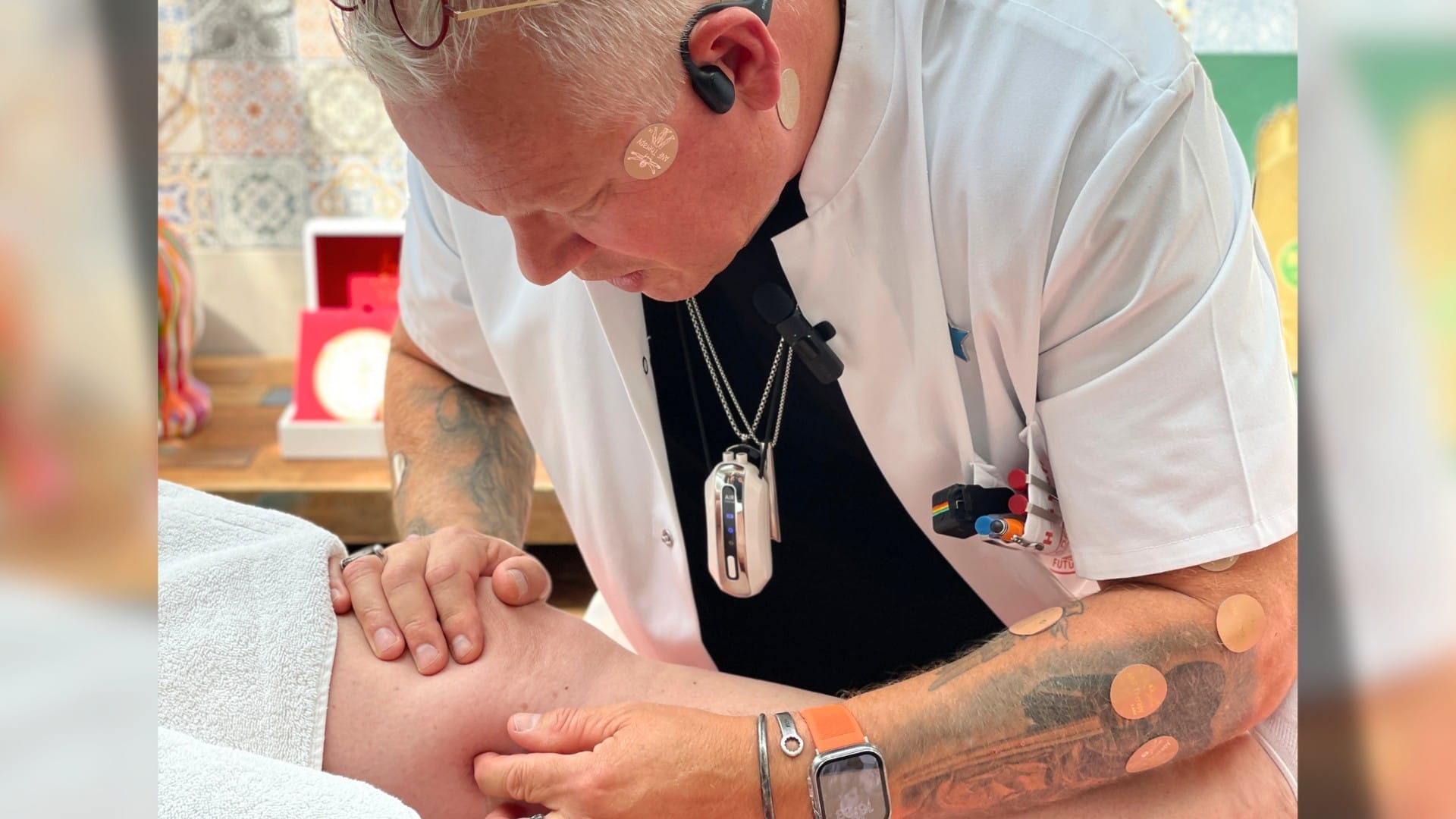
Table of Contents
Trigeminal neuralgia is a chronic pain condition that usually affects one side of the face. It happens because of problems with the trigeminal nerve, which sends signals from the face to the brain. People with trigeminal neuralgia often feel sudden, sharp pain like an electric shock in one of these areas. It could be due to everyday activities such as eating, talking, or light touch.
ANF Therapy®️ is an advanced treatment approach for trigeminal neuralgia. It works on the principles of frequency medicine and employs ANF Devices charged with certain frequencies to correct neurological imbalances in the body. This noninvasive and nonsurgical approach aims to activate the body’s natural healing process by targeting and strengthening neurological frequencies.
What is Trigeminal neuralgia (TN)?
The term “trigeminal” comes from the Latin words “tria,” meaning three, and “geminus,” meaning twin. This condition can affect the right or left side of the face. The trigeminal nerve (the nerve affected in this condition) is the largest cranial nerve responsible for facial sensation, with one nerve on each side of the head. Each trigeminal nerve branches into three parts:
- Ophthalmic nerve controls sensation in the forehead, eye, and upper eyelid.
- Maxillary nerve: It controls sensation in the lower eyelid, nostril, cheek, upper gums, and upper lip.
- Mandibular nerve: It controls sensation in the lower gums, lower lip, jaw, and some muscles used for chewing.
What is the prevalence of TN?
Around 150,000 trigeminal neuralgia (TN) cases are diagnosed annually in the United States. While it can occur at any age, it is more common in people over 50. However, it can also develop in younger adults, usually in their 20s or 30s. It’s quite rare in children. Plus, the risk of TN in women is double that of men.
Estimates suggest that about 0.3% of people will experience trigeminal neuralgia at some point.
What are the symptoms of TN?
- Type 1 (TN1): Sudden, severe pain around the eyes, lips, nose, jaw, forehead, and scalp. It can happen several times a day, with breaks in between. Over time, the pain worsens, leading to more frequent and more prolonged spells.
- Type 2 (TN2): Involves a more constant, dull, burning ache that may come with sharper pain. Though it’s not as intense, it can happen more often.
- Sudden, brief attacks of sharp or shooting pain lasting from a few seconds to about two minutes
- A burning or aching feeling may occur before the sharp pain starts.
- Pain episodes can happen regularly for days, weeks, or months and sometimes disappear completely for a long time (this is called remission).
- Pain usually affects the cheek, jaw, teeth, gums, lips, and occasionally the forehead and eyes.
- Intense pain may lead to involuntary twitching of the face, which is why TN is also known as tic douloureux.
- Some people may feel anxious because they don’t know when the pain will return.

What are the common triggers of TN?
Certain everyday activities can act as triggers for TN symptoms, including:
- Shaving
- Applying makeup
- Washing your face
- Eating and drinking
- Brushing teeth or using mouthwash
- Smiling, talking, or even laughing
- Light touch
- Environmental factors such as a gentle breeze on the face
These painful episodes rarely occur during sleep, making the condition more unpredictable.
What are the causes of TN?
The maleadingause of trigeminal neuralgia (TN) is often pressure or damage to the trigeminal nerve. However, based on the cause, there are three types of TN:
1. Classical Trigeminal Neuralgia
Classical trigeminal neuralgia occurs when the trigeminal nerve gets compressed just before it enters the brain stem (pons). In 80% to 90% of cases, this compression is caused by nearby blood vessels, including:
- Superior cerebellar artery: It is the main artery responsible for 75% to 80% of cases. It supplies blood to the cerebellum, which controls balance and coordination.
- Petrosal vein: It drains blood from the inner ear and nearby areas.
- Anterior inferior cerebellar artery: It supplies blood to the lower part of the cerebellum.
- Vertebral arteries: They supply blood to the back of the brain.
2. Secondary Trigeminal Neuralgia
Secondary trigeminal neuralgia occurs when another medical condition affects the trigeminal nerve. It can include growths like tumours or cysts directly pressing on the nerve.
Conditions like multiple sclerosis (MS) can also lead to secondary trigeminal neuralgia. In MS, the demyelination (damage to the protective covering) of the trigeminal nerve disrupts normal nerve function, leading to painful symptoms. This accounts for about 2% to 5% of TN cases.
3. Idiopathic Trigeminal Neuralgia
The cause remains unknown in this case. It may occur as sudden, sharp pain or as constant pain.

What are the risk factors of TN?
Multiple factors can increase the risk of trigeminal neuralgia, including:
- High blood pressure
- Smoking
- Age
- Gender
- Family history
How to fix Trigeminal Neuralgia?
Treatment of Trigeminal Neuralgia with ANF Therapy®️?
Diagnosis of trigeminal neuralgia is a step-by-step approach that includes a detailed history, clinical examination, neurological assessment, and application of ANF Devices, followed by follow-up sessions. They will also rule out other diseases with the same signs and symptoms.
1-History:
Your ANF therapist will start the treatment by asking a few questions. They may provide you with a questionnaire related to your condition. These include:
- Nature/severity of pain
- Location of pain
- Is pain on one side or on both sides?
- Do you feel pain when touching your face, shaving, or chewing?
- Pain triggers and zones
- Any history of sinus or jaw pain?
- Do you feel a sensation of electric shock in the affected area?
2-Physical and Neurological Examination:
After a detailed history, your ANF Therapist will perform a detailed physical and neurological examination. They will check facial and jaw movements, inflammation in nerves, and affected areas. They will palpate your nerves with their fingers to assess the severity of inflammation.
3-Application of Devices:
Based on the assessment, your ANF Therapist will strategically apply ANF Devices to certain parts of your body. These devices are designed to work synergistically to address various health issues.
The primary function of the ANF Devices is to reduce inflammation, which is a common source of pain and discomfort. These devices aim to alleviate these symptoms by resolving inflammation from its root cause. They are designed to optimise neural oscillations and activate the body’s natural healing process.
ANF Devices also play a crucial role in strengthening nerve signals. By improving the communication between nerves and muscles, these devices help restore nerve and muscle function and strength. This enhancement of nerve signals leads to better coordination and overall muscle performance.
4-Expected Outcome:
Most patients feel an improvement in their symptoms after a few minutes of applying ANF Devices. Individual response may vary depending on the severity of conditions and the body’s response. This therapy aims to reduce pain by 50% after the first session.
5-Follow-up:
Regular follow-ups are essential to treat trigeminal neuralgia using ANF Devices. Your ANF Therapist will guide you on the number of follow-up sessions and treatment duration. You will need to change ANF Devices after 72 hours. Your therapist will create a personalised treatment plan for you and educate you on changes and the total number of sessions required to manage trigeminal neuralgia.

Start your journey with ANF Therapy®️:
ANF Therapy®️ offers an innovative tool for managing trigeminal neuralgia. It utilises wearable ANF Devices (small, circular, wearable devices) that emit neurological frequencies. ANF Therapy®️ aims to modulate inflammatory responses, promote healing, and support overall well-being related to health. This non-pharmacological therapy provides a safe and effective approach that improves disease outcomes by targeting the root cause. If you’re suffering from trigeminal neuralgia, consult an ANF Practitioner or find an ANF Therapist to start your treatment with ANF Therapy®️ today!
If you’re a healthcare practitioner who wants to enhance your clinical skills with ANF Therapy®️, visit www.anfacademy.com to learn more about the ANF Clinical education program.
About ANF Therapy®️
ANF Therapy®️ uses circular ANF Devices, which are applied directly on the skin after palpation and assessment by a trained ANF Therapist following the ANF Therapy®️ Method, Patented Model no. U202030252, ES1259974.
The ANF Therapy®️ purpose is the alleviation of injury and pain within minutes.
Our aim is that the patient experiences a reduction of pain and swelling, an increase in range of motion, and an improvement in quality of life related to health. Non-transdermal, non-invasive device, NO needles or chemicals are used.
Do you need help with your health issues? Have you been experiencing symptoms of Trigeminal Neuralgia?
Contact us, and we will explain how we can help you!


